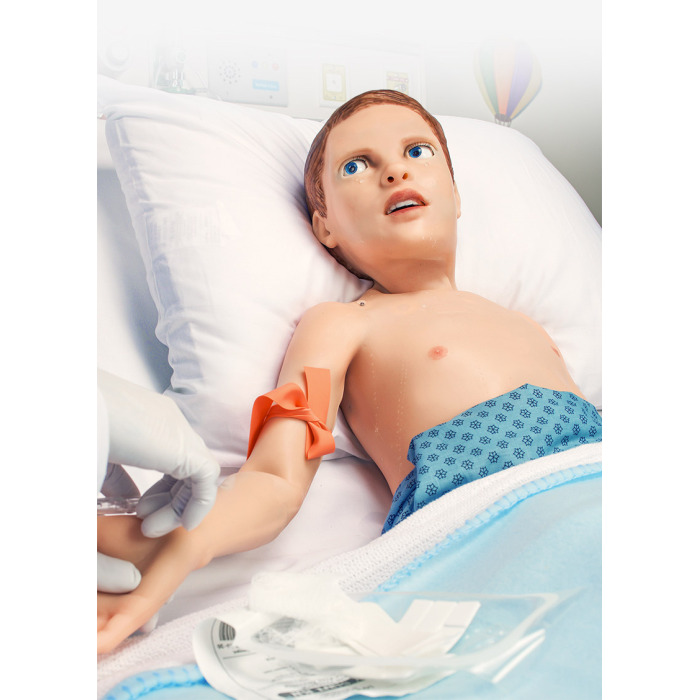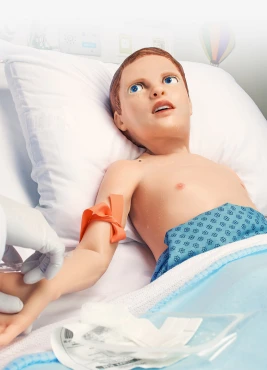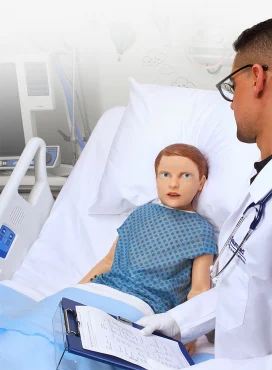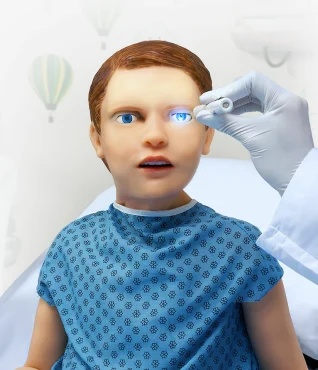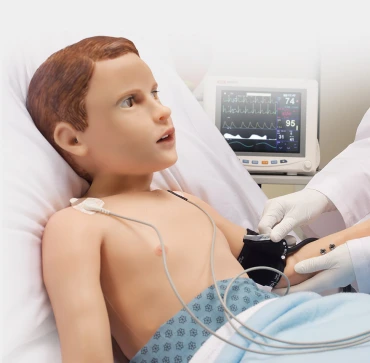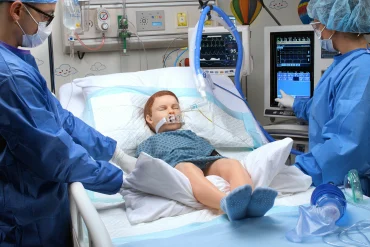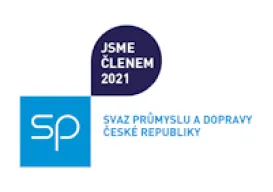S2225 - Pediatric HAL Patient Simulator
The world's most advanced pediatric patient simulator and the first capable of simulating lifelike emotions through dynamic facial expressions, movement, and speech. HAL is designed to help providers of all levels develop the specialized skills needed to effectively communicate, diagnose, and treat young patients in nearly all clinical areas.
Immerse participants in the most realistic and engaging Simulation Learning Experiences yet.
Pediatric HAL includes 10 outcome-focused scenarios designed to replicate a variety of clinical situations throughout the spectrum of pediatric care. A detailed written guide accompanies each Simulation Learning Experience™ for setting up, planning, and facilitating the learning experience.

Introducing lifelike facial expressions and emotions—a revolutionary new level of interaction and richer patient-provider communication.
Through scenario-based learning, HAL can help participants to assess verbal and non-verbal cues to build patient-provider communication skills and empathy.
In addition to illustrating nearly a dozen facial expressions, HAL also simulates a variety of common emotional states to better approximate behavior. Simply set HAL’s emotional state to lethargic, for example, and the eyelids will droop automatically, head movement will slow, and yawning will occur periodically. What's more, the powerful UNI software lets you create your own facial expressions and emotions to expand the scope the learning experiences. The UNI library includes the following presets to get you started:
- Anger
- Transient pain
- Ongoing pain
- Amazed
- Quizzical
- Worried
- Anxious
- Crying
- Yawning
- Lethargic
Truly comprehensive pediatric patient assessment exercises.
Interactive eyes and color-changing skin allow Pediatric HAL to illustrate signs of varying emotional states, trauma, and many other neurological diseases and conditions.
- Accommodation test: automatic horizontal tracking and manual vertical tracking
- Strabismus: exotropia and esotropia
- Nystagmus: eyeball twitching
- Blepharospasm: eyelid twitching
- Ptosis: eyelid droop
- Realistic idle eye movement
- Independent pupillary light reflex
- Mydriasis: blown pupil
- Anisocoria: unequal pupil sizes
- Programmable blinking rate
- Consensual pupillary light reflex
HAL features high-fidelity heart, lung, and bowel sounds. Auscultation is clear and free of interference thanks to internal components designed to operate silently.
- Independent normal/abnormal heart sounds at aortic, pulmonic, and mitral sites
- Anterior and posterior lung sounds
- Spontaneous breathing and selectable normal and abnormal respiratory patterns
- Programmable unilateral chest rise and fall

Practice using real patient monitors and sensors.
Pediatric HAL supports a broad range of real patient monitors and sensors. This unique capability allows participants to practice setting up and operating equipment just as they would in real situations.
- ECG/EKG monitors
- ECG derived respiration monitoring support
- Oximeters
- Capnographs
- Defibrillators
- NIBP monitors
- Glucose meters
- Palpable pulses: bilateral carotid, brachial, radial, femoral, and pedal
- Bilateral forearm IV access supports sampling and continuous infusion
- Capillary refill time testing
- Blood pressure dependent pulses
- Urethral catheterization with programmable flow
The next-generation in pediatric advanced life support simulation.
Thanks to its ultra-high fidelity anatomical and physiological features, Pediatric HAL supports the practice of advanced-level algorithms using real tools and clinically accurate techniques.
- Wireless and tetherless; fully functional during transport
- Anatomically accurate oral cavity and airway
- Surgical airway
- Laryngospasm and tongue edema
- Visible chest rise following guideline recommended flow, PIP, and PEEP values
- SpO2 and etCO2 monitoring
- Anterior/posterior defibrillation
- eCPR™ Real-time quality feedback and reporting
- Compression depth, rate, and interruption duration
- Ventilation rate and duration
- Smart CPR voice coach
- Performance report summary
Immersive skills-training in emergency intervention and management.
Pediatric HAL features surgical sites for needle decompression and chest tube insertion exercises using real instruments.
- Palpable and anatomically accurate bony landmarks
- Realistic skin supports cutting and suturing
- Chest tube site bleeds when cut and releases fluid upon tube insertion
- Tactile pleural "pop"
- Audible hiss during needle decompression
- Needle and chest tube insertion detection and logging
- Palpable cricoid cartilage and cricothyroid membrane
- Permits tracheostomy, cricothyrotomy, and retrograde intubation using real instruments
- Supports positive pressure ventilation via surgical airway
- Programmable difficult airway: laryngospasm and tongue edema

True mechanical ventilation support for advanced respiratory care simulation.
Pediatric HAL responds to mechanical ventilation support using real equipment just like an actual patient and can simulate the course of respiratory disease through treatment, weaning, and rehabilitation with the highest degree of physiological accuracy.
The patented dynamic lung system in Pediatric HAL requires no manual calibration, external intermediary adapters, or setup boxes. Simply connect HAL to the ventilator and tap the UNI controls to change lung functionality on the fly.
- Modes supported include: ACV, SIMV, CPAP, PCV, PSV
- Programmable respiratory patterns
- Supports therapeutic levels of PEEP
- Programmable airway and lung function
- Dynamic lung compliance (low to high)
- Bilateral bronchi resistance
- Respiratory effort triggers ventilator during weaning
Ready to integrate into your program with Simulation Made Easy®.
Pediatric HAL is a complete learning solution and includes everything you need to get started including the powerful UNI® Tablet PC and 10 Simulation Learning Experiences.
The UNI simulator control software provides you with all the tools you need to deliver a rich simulation experience from one intuitive interface. UNI features precise touch-based controls, task automation, real-time feedback, and automatic data capture tools designed to operate seamlessly during even the most complex scenarios.
Preconfigured and Ready
Pediatric HAL is preconfigured and ready for use right out of the box.
Optimized For On-The-Fly Controls
The UNI touchscreen interface lets you quickly and easily adjust vital sign parameters with just a few taps.
3D Patient Visualization Monitor
This real-time 3D view of the patient ensures you never lose track of provider/patient interactions during the simulation.
Scenario Designer
Create your own scenarios quickly and easily and share them with other UNI users.
eCPR™
Monitor rate and compression depth, no-flow time, ventilation rate, and excessive ventilation. Smart trainer features vocal cues and outputs performance reports.
Lab Report Designer
Generate and share simulated diagnostic lab results to enhance case fidelity and participant involvement.
Questionnaire Form Designer
Manage progress by easily creating interactive checklists to track participant objectives and post-simulation feedback.
Time Stamped Event Recording And Reporting
The automated event tracking and interaction recorder ensures important events are always captured so you can focus on the action.
Provider Actions Tracker
The interactive “Actions” panel lets you carefully track additional team and individual provider actions to generate a comprehensive post-simulation log.
UNI Control View Replay
The built-in recorder captures UNI’s screen as data to allow your team to review the simulation from the operator’s chair.
No Annual Software License Fee
Gaumard is committed to providing the best value and keeping your program’s operating costs down year after year.
Free Software Updates
Always stay up to date and take advantage of all the newest features at no additional cost.
Free Webinar Training And Technical Support
Sign up for our monthly webinar sessions and become a UNI expert.

Features summary
GENERAL
- Height: 44 inches
- Tetherless and wireless; fully responsive during transport
- The internal rechargeable battery provides hours of tetherless operation
- Smooth and supple full-body skin with seamless trunk and limb joints
- Realistic joint articulation: neck, shoulder, elbow, hip, and knee
- Palpable bony landmarks
- Forearm pronation and supination
- Supports common patient positions including Fowler’s, supine, and sitting
- Male/female patient conversion
- Tablet PC preloaded with UNI® included
- OMNI®2 ready
- Includes 10 preprogrammed SLEs and facilitator’s guidebook
NEUROLOGICAL
- Active robotics simulate lifelike facial expressions including:
- Anger
- Transient pain
- Ongoing pain
- Amazement
- Quizzical
- Crying
- Yawning
- Preprogrammed emotional states automatically express associated verbal and non-verbal cues without manual input
- Worried
- Anxious
- Lethargic
- Distracted
- Create custom facial expressions via UNI® interface
- Programmable jaw movement, bilateral or unilateral brow movement, and horizontal neck rotation
- Automatically turns head and eyes towards the approaching subject
- Stiff neck (torticollis)
- Interactive eyes: eyes can automatically follow a moving object
- Programmable blinking rate, pupil response, and bilateral and unilateral eye movement
- Independent, active pupillary light reflex
- Abnormal eye and eyelid movements: cross-eyed, nystagmus, eyelid twitching, eyelid droop
- Programmable crying/tears release real fluid
- Wireless streaming voice: be the voice of HAL and listen to participants respond in real-time
- Real-time voice modulation effects
- Automatic jaw movement synchronized with speech
- Seizures with selectable intensity levels
- 50+ prerecorded speech responses
AIRWAY
- Anatomically accurate oral cavity and airway
- Supports nasotracheal/orotracheal intubation with standard instruments including endotracheal tubes and supraglottic airway devices
- Tracheal intubation detection
- Head tilt, chin lift, jaw thrust
- Supports esophageal intubation
- NG/OG tube placement
- Supports bag-valve-mask ventilation
- Realistic surgical trachea permits tracheostomy, cricothyrotomy, and retrograde intubation
- Programmable difficult airway: laryngospasm and tongue edema
- Selectable normal and abnormal upper airway sounds
BREATHING
- Spontaneous breathing and selectable normal and abnormal respiratory patterns
- Variable respiratory rates and inspiratory/expiratory ratios
- Programmable unilateral chest rise and fall
- Unilateral chest rise with right mainstem intubation
- Real CO2 exhalation: supports etCO2 monitoring using real sensors and monitoring devices
- Selectable normal and abnormal sounds: upper right front and back, upper left front and back, lower right back, and lower left back
- Real mechanical ventilation support
- A/C, SIMV, CPAP, PCV, PSV, and more
- Supports therapeutic levels of PEEP
- Programmable variable lung compliance
- Variable bronchi resistance
- Programmable respiratory efforts for weaning/liberation
- Real-time ventilation feedback
- Visible chest rise during BVM ventilation
- Chest tube insertion: left midaxillary haemothorax site features palpable bony landmarks, realistic skin for cutting and suturing, tactile pleural pop, and fluid drain
- Needle decompression site features realistic tactile feedback and audible hiss
- Needle decompression and chest tube insertion detection and logging
CARDIAC
- Includes comprehensive library of ECG rhythms with customizable beat variations
- Independent normal/abnormal heart sounds at aortic, pulmonic, and mitral sites
- Supports ECG monitoring using real devices
- Supports ECG-derived respiration monitoring (EDR)
- eCPR™ Real-time quality feedback and reporting
- Time to CPR
- Compression depth/rate
- Compression interruptions
- Ventilation rate
- Excessive ventilation
- Smart CPR voice coach
- Effective chest compressions generate palpable femoral pulses
- Defibrillate, cardiovert and pace using real devices and energy
- Anterior/posterior defibrillation sites
- Supports double sequential external defibrillation (DSED) up to 150 Joules
CIRCULATORY
- Visible cyanosis, redness, pallor, and jaundice
- Supports capillary refill time testing above the right knee; test detection and logging
- Palpable pulses: bilateral carotid, brachial, radial, and femoral
- Blood pressure dependent pulses
- Supports blood pressure monitoring using a real NIBP cuff and monitor
- SpO₂ monitoring using real devices
VASCULAR ACCESS
- Bilateral forearm IV access supports sampling and continuous infusion
- Intraosseous infusion site at right proximal tibia
- Real glucose test readings via finger-stick
GASTROINTESTINAL
- Patent esophagus
- Gastric distension during excessive PPV
- Bowel sounds in four quadrants
- Interchangeable male/ female genitalia
- Supports urinary catheterization with fluid return
- Programmable urinary output
- Quantitative unit
- ks
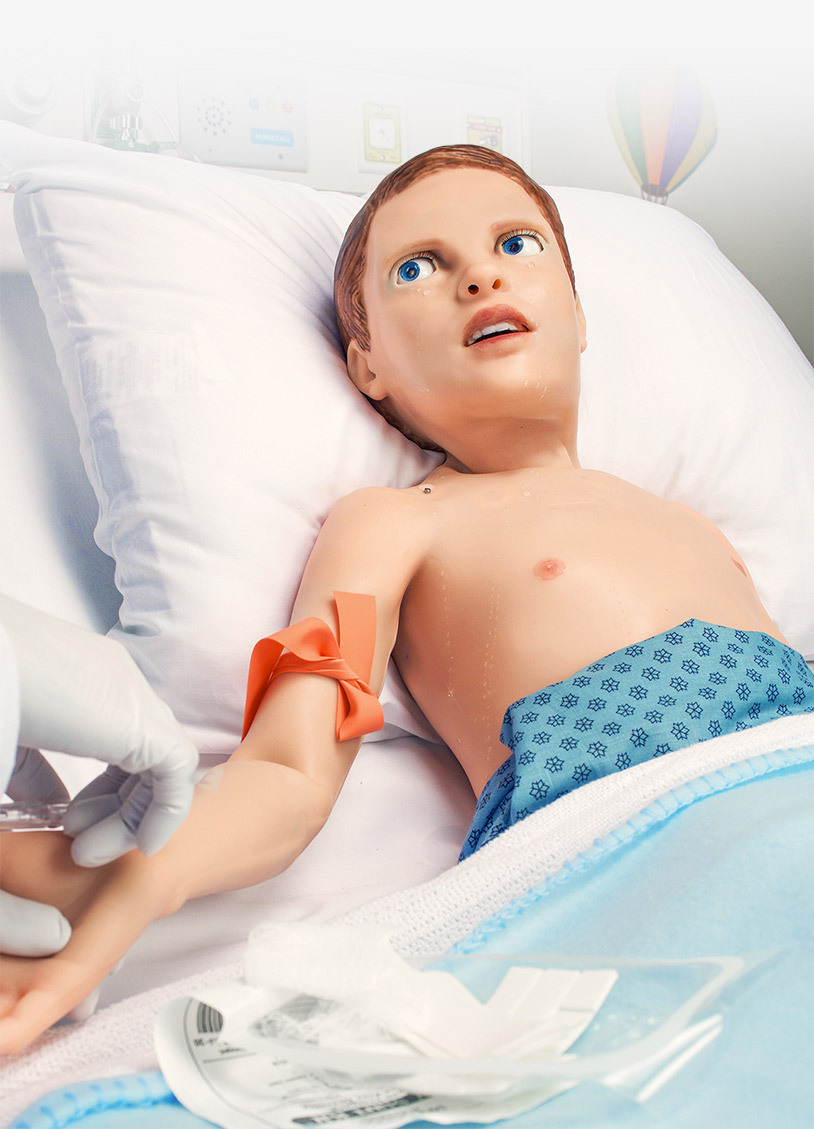
S2225 - Pediatric HAL Patient Simulator
